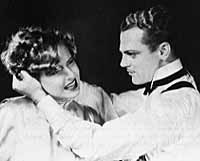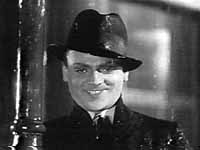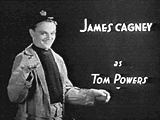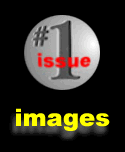











|

James Cagney and Mae Clarke in Lady Killer
James Cagney as Tom Powers in Public Enemy.

James Cagney as Tom Powers vs. Donald Cook as his brother in Public Enemy.
| During the early 1930s, Cagney was all of this and more. His uptempo acting style--the rat-a-tat-tat of his reedy voice--and his distinctly Irish-puck appearance, created a decidedly lower-East side aura. When he leaned into a room, fists clenched, he dominated the mise-en-scene like a careening car. His grin--cocky, self-assured, masculine--said I'm better than you and I know it. And his roving eyes, stabbing stubby forefinger, and flexed body were a bunch of city lights, exploding like firecrackers.
Cagney began work at Warners in a series of small roles before electrifying audiences as the indomitable Tom Powers in Public Enemy (1931). Cagney shows Powers's brash, cocky spirit, with body language that exudes energy and violent tempo. Walking down the back alleys to Putty's club, Cagney spins, spits, and pushes his "newsie" hat over his head with languor.
|
Cagney's sulky energy and the film's theme appealed to the down-trodden working class. The film's opening credits offer two paths for the immigrant: conformity or rebellion. The lawless Cagney wears an unbuttoned shirt and open collar that represents freedom from restraint. He smiles, gives two right jabs and raises an eyebrow while winking. Older brother Michael (Donald Cook), trapped in a tight-fitting conductor's uniform, looks straight ahead with a solemn, dour expression. Cagney's anarchy is presented as engaging. Cook's conformity binds and overwhelms his individuality.
The film is by now famous for an enduring still in which Cagney, with lips pursed, hair awry, and eyes enraged, smashes a grapefruit in Mae Clarke's face. But it was Tom's contempt for assimilation, rather than his contempt for women, that alarmed educators and reformers. "Aw that sucker. He's too busy going to school. He's learning how to be poor," Tom says of his brother, a "ding-ding" on the streetcar. In 1932-33, armed with the Payne Studies, a group of Chicago sociologists feared that immigrant youths would over-identify with certain screen stars and surrender their parents' values for the falsely "Americanized" ones on screen. In his popular account of the Payne report, Henry James Forman echoed these sentiments when he identified one second-generation Italian youth's praise for Cagney: "I eat it. You get some ideas from his acting. You learn how to pull off a job, how he bumps off a guy and a lot of t'ings."
Because of these incumbent pressures and the ascendancy of President Roosevelt and his call for collective action, Warner Brothers became a "New Deal" studio and shifted its narrative emphasis from lost-world losers to common men trying to make it in America.
|
 Taxi (1932) was Cagney's first film to take on this new role, and an exhibitor's ad showcased Cagney as a point of ethnic identification. He grins, his left hand and thumb raised with friendly greeting. The ad's art-deco lines and shapes combine with the circle that spotlights his name to create an airy uptown romantic aura, while the copy inside the spotlight brings Cagney back to the lower-East side.
Taxi (1932) was Cagney's first film to take on this new role, and an exhibitor's ad showcased Cagney as a point of ethnic identification. He grins, his left hand and thumb raised with friendly greeting. The ad's art-deco lines and shapes combine with the circle that spotlights his name to create an airy uptown romantic aura, while the copy inside the spotlight brings Cagney back to the lower-East side.
He's an outlaw: fast paced ("speed"), two-fisted ("Fightingest"), lawbreaking ("skipped a stop light"), Irish ("red-head"), and a New Yorker, promising to give immigrants the "lowdown": follow me and we'll fight to make it.
page 1 of 2

|
|












 Taxi (1932) was Cagney's first film to take on this new role, and an exhibitor's ad showcased Cagney as a point of ethnic identification. He grins, his left hand and thumb raised with friendly greeting. The ad's art-deco lines and shapes combine with the circle that spotlights his name to create an airy uptown romantic aura, while the copy inside the spotlight brings Cagney back to the lower-East side.
Taxi (1932) was Cagney's first film to take on this new role, and an exhibitor's ad showcased Cagney as a point of ethnic identification. He grins, his left hand and thumb raised with friendly greeting. The ad's art-deco lines and shapes combine with the circle that spotlights his name to create an airy uptown romantic aura, while the copy inside the spotlight brings Cagney back to the lower-East side.

 Barbara Stanwyck
Barbara Stanwyck Joan Crawford
Joan Crawford




